During the 19th century, Santa Cruz was one of the largest ports in Northern California thanks to a variety of booming industries including lumber, agriculture, and lime, a key element of the cement that built cities such as San Francisco. The region teemed with wharves and piers to transport goods to sea-based ships, yet, over the years, nearly all were dismantled or swept away by ferocious storms. Today, you can still explore three remaining piers, and marvel at the popular ruins of a fourth. Originally constructed to ship local products abroad, the wharves and piers that dot the Santa Cruz County shoreline today deliver an abundance of scenery, history, and good eats.
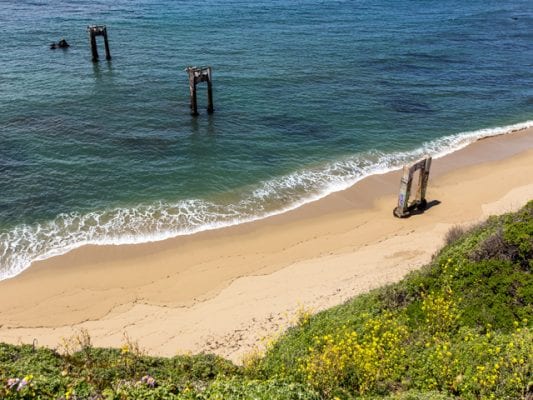
Davenport Pier
While Rome has the Colosseum, the quiet coastal town of Davenport has the Davenport Pier. The popular ruins of this former pier are composed of rustic beams jutting from the shoreline and enjoy Instagram celebrity status. Yet, many fans incorrectly credit the pier to John Davenport, a 19th century whaler from whom the town takes its name. Davenport settled the area in the 1860s and constructed a small wooden pier near what is now Davenport Landing Beach. The pilings seen today are the remains of a 2,327-foot pier built by the Davenport Cement Plant in 1934. The defunct plant, whose machinery can still be seen towering above the cozy village, was once the driving force behind the town’s development in the early through the mid-20th century.
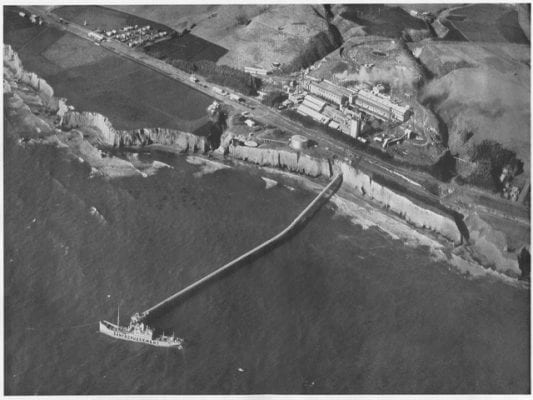
The pier was constructed of steel—an engineering feat for the time, and the first on the Pacific Coast—and served the plant’s transportation needs until 1955, when a storm washed away a sizable portion which was never rebuilt. Today, the pier’s weathered beams serve a community of photographers from abroad. The ghostly remnants are one of the most photographed scenes in Santa Cruz County and have famously sported swings and artwork by local artists such as Jeremiah Kille. Yet, because of the beach’s extremely steep and unstable cliffside, visitors are urged to remain on the bluffs above which provide a perfect vantage point for excellent—and safe— shots of the pier.
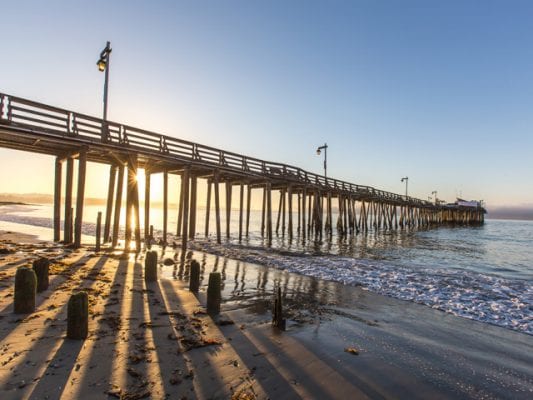
Capitola Wharf
One interesting fact about the Capitola Wharf is that it predates the city of Capitola. When the wharf was constructed in 1857 to load steamships with lumber from the surrounding mountains, the area was referred to as Soquel Landing. It wasn’t until the 1870s, when the camping resort of “Camp Capitola” was established that the colorful, seaside village we know today began to take shape. Soon, the resort became known as Capitola-by-the-Sea—some suspect the name “Capitola” was inspired by the female protagonist of E.D.E.N. Southworth novels—and tourists began flocking to the what is now considered the oldest seaside resort on the Pacific Coast. As tourism boomed, the wharf’s shipping role was eclipsed by a new railroad, and the wooden promenade became more popular with Italian fishermen than lumber barons.
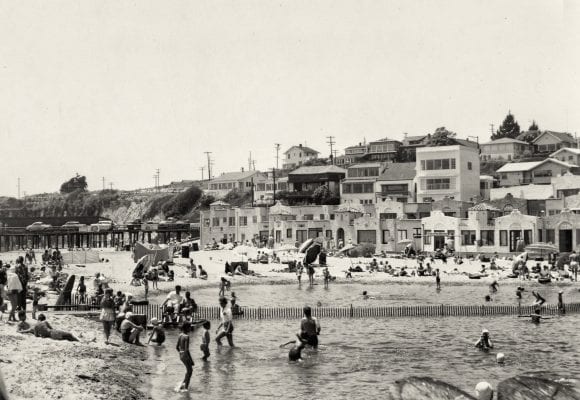
Over the years, numerous leaseholders managed the wharf, and the wharf dipped into periods of disrepair as strong storms thrashed the mid-1800s structure. In an especially perilous storm in 1913, a stranded fisherman is rumored to have been saved by local, Hall of Fame baseball star Harry Hooper who, today, has a plaque in his honor mounted at the foot of the wharf. It wasn’t until 1979 that the City of Capitola took ownership of the tidelands beneath the wharf, and renovated the structure in 1981 to its current appearance today. Today, the 855-foot promenade features free fishing—like all public piers in California—a bait shop, and boat rentals, as well as The Wharf House restaurant dishing up seafood faves and sunset drinks. Yet, most visitors are content to stroll its lengthy expense, pausing to gaze upon on the postcard views of Capitola Village, and the surrounding shores of Capitola Beach lapped by the gentle waves of Monterey Bay.
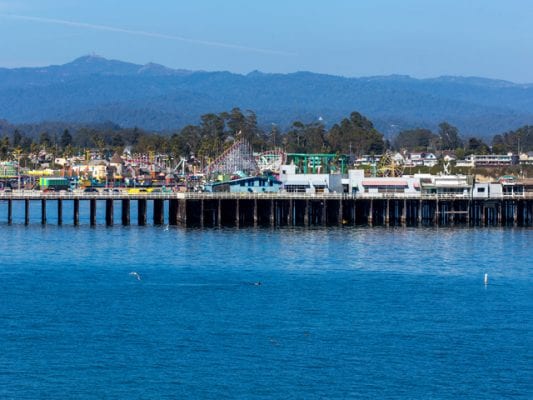
Santa Cruz Wharf
At 2,745 feet, the Santa Cruz Municipal Wharf is the longest wooden wharf on the West Coast, offering visitors sights usually only seen from being at sea. From the wharf’s lengthy expanse, you can watch surfers roll in from famed surf break Steamer Lane, spot sea life such as frolicking, barking sea lions, and watch fishermen reel in today’s catch. Known colloquially as the Santa Cruz Wharf, history buffs, and wharf enthusiasts refer to it as the Municipal Wharf, distinguishing it from the six wharves that once extended from the stretch of shoreline linking Lighthouse Point to the San Lorenzo River (one such example was the famed 1907 Pleasure Pier which supplied fresh seawater to The Plunge, a heated, indoor pool at the newly constructed Boardwalk).
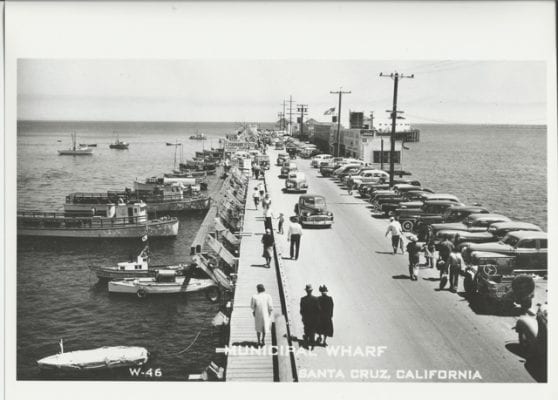
None of these six former wharves could host large, deep-water ships, so the Municipal Wharf was built in 1914, fashioned from more than 2,000 Douglas fir pilings implanted in the ocean floor. The wharf immediately bustled with fishermen, many Italian immigrants such as the Stagnaros family who have operated a fish market and subsequent restaurant on the pier since 1937. Slurping a piping hot bowl of clam chowder, or forking into a fresh crab louie from their restaurant at the end of the pier is a timeless Santa Cruz tradition. Ditto the salt-water taffy and waterfront vistas that you’ll enjoy from a saunter along this Santa Cruz landmark.
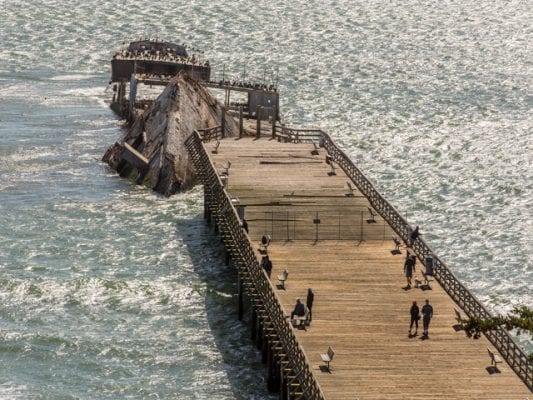
Seacliff Beach Pier
The pier at Seacliff State Beach features the usual attributes of most wharves— stirring waterfront vistas, the poles and nets of hopeful fishermen—with one peculiar exception. Resting at the end of the 630-foot pier are the sea-battered remains of a 1919 concrete oil tanker. Built for WWI, the 420-foot S.S. Palo Alto featured a hull of concrete given a wartime shortage of steel. Yet, the war ended shortly after its completion, and the newfangled freighter never saw service. Instead, the forsaken ship was purchased by the enterprising Cal-Nevada Stock Company who transformed it into a floating, nightlife venue with a casino, restaurant, and dancehall.
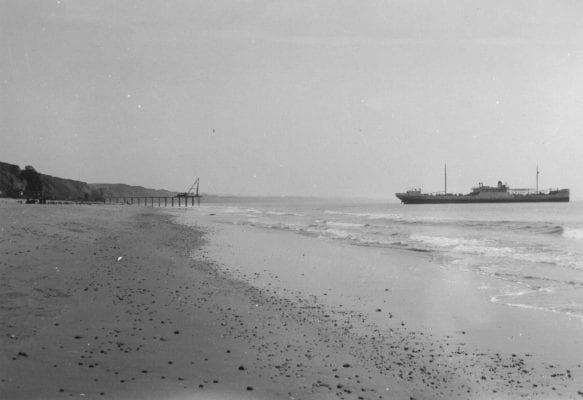
The Palo Alto was tugged from its Oakland shipyard to the waters just off Seacliff Beach, and a pier was built to link the ship to shore. A neon sign advertising “The Ship” was perched on the cliffs above, and revelers soon flocked to the new, decked-out pleasure boat. Yet, thanks to the Great Depression, the festivities lasted only two years, and the ship became an abandoned, seaside throwback to a merrier time. Today, the weathered ship is closed to the public—numerous storm surges have left it in ruins—yet its concrete remains host a thriving ecosystem of marine life including fish, harbor seals, and seabirds. Visitors are welcome to stroll the 500-foot pier, which has remained open since its inception and view the old ship and its swarming population of pelicans and gulls. Or, simply enjoy sweeping views of Monterey Bay from one of the many benches that line the wood-planked deck.
For more information on the historic wharves and piers around the county, click here!
Updated 2022
